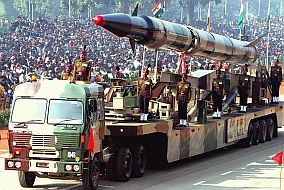With an estimated 90 to 110 nuclear warheads, and enough fissile material stockpiled to build another 40 to 100 bombs, Pakistan is already the world's No. 6 nuclear military power. It has passed its main nemesis, India, and if things continue unchecked, it could move into third place, behind the US and Russia, by the end of the decade.
But Pakistan's bomb-making prowess stands in embarrassing contrast to its failure to develop a meaningful non-military nuclear power infrastructure.
Pakistan is a poor country desperate for energy. This summer, as temperatures routinely soar past 110 degrees, an acute shortage of electricity has resulted in planned daily power outages across the country that now last up to 18 hours a day. Citizens seethe as they swelter. Riots and gunfire have broken out in several cities.
And despite promises from politicians, there is no relief in sight. Pakistan's new prime minister, Raja Pervaiz Ashraf, held the water and power portfolio before taking over for former Prime Minister Yousaf Raza Gilani, who was ousted by the judiciary in June, so he bears no small part of the responsibility for the current mess.
Ashraf has vowed to restore electricity to all citizens of Pakistan—apparently starting with himself. According to the outraged local press, one of Ashraf's first acts upon taking over the premiership was to have his villa on the outskirts of Islamabad provided with round-the-clock power. And a heliport to beat the morning rush hour traffic.
Pakistan's power producing capacity of about 20,000 MW falls about 4,500 to 7,500 MW short of what it needs, according to various official estimates. Nuclear power from two reactors contributes only about 725 MW to the total.
It wasn't supposed to be this way. Back in the 1950s, when President Dwight Eisenhower announced the Atoms for Peace program, Pakistan, India and Iran were the poster children of the American initiative to promote peaceful applications of nuclear power in developing countries.
But in the mid-1960s, when India began to show signs of developing a nuclear weapons program, former Pakistan president and prime minister Zulfikar Ali Bhutto, who was then foreign minister, pledged that Pakistan would also build a bomb—even if it meant the Pakistani people had to "eat grass or leaves, or go hungry" to do so.
India conducted its first nuclear test in 1974. Since then, both countries have been locked in an expensive arms race—far more expensive, relatively speaking, for Pakistan because its stagnant economy is only one-eighth the size of India's.
After both countries tested weapons in 1998, India has proven much better than its rival in finessing the international opprobrium that comes with being an uninvited member of the nuclear weapons club. In 2008, New Delhi achieved a major breakthrough when it negotiated a very favorable deal with the Bush administration that ended a decades-long embargo on the transfer of civil nuclear technology.
"Under current international nuclear policy Pakistan is not eligible for nuclear trade because of its nuclear weapons program," said Toby Dalton, deputy director of the Nuclear Policy Program at the Carnegie Endowment for International Peace. "India received an exemption to these policies in 2008, allowing it to purchase uranium and nuclear technology on the international market."
India's deal with the U.S., which remains controversial within the global nuclear community, has only heightened anxieties in Pakistan, whose sole nuclear supplier is China.
Although Pakistan's leaders continue to tout nuclear energy as the solution to the country's energy problems, this appears to be highly unrealistic. Given Pakistan's constant state of political turmoil, its strained relations with the U.S., its reputation for harboring terrorists and the A.Q. Khan network's dealings with Libya and North Korea, the U.S. government and the rest of the nuclear community (except China) will not be inclined to give Pakistan the kind of concessions that were given to India. And also, as Dalton explained, nuclear reactors are very expensive and take a long time to build.
"My argument isn't that nuclear power doesn't make sense for a country like Pakistan that has significant baseload need, but with a highly unstable grid and moribund economy, there are cheaper and faster ways for Pakistan to improve its energy situation than using nuclear," said Dalton, who previously headed the Department of Energy's office at the U.S. Embassy in Pakistan.
But unless Pakistan's leaders change course, it appears the people of Pakistan will continue to eat grass, endure 18 hours a day of blackouts and take their comfort in the dubious prestige that comes with being a member of the select club that holds the power of nuclear annihilation.
Editor's note: This story has been corrected to reflect Pakistan's status as the world's No. 6 nuclear military power.
- Document





